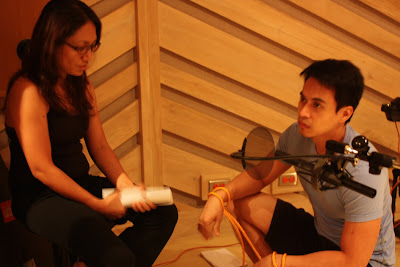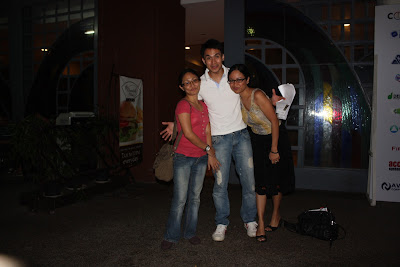At one point during the early days of the project, I considered shooting the two present-day sequences as live-action parts. But at the end of it, after thinking deeply of the various considerations of doing so, I decided to make it an entirely animated work with no live-action parts.
Some 3D CGI projects do a similar workflow using motion-capture technology, some do rotoscoping. For us, it's as old school as simply shooting the actors on video to serve as reference and inspiration for the animators.
Instead of merely recording the actors' voices, we chose to both record their voices and shoot videos of them for the use of the animators. We intend to use the voice recording elements as final ones, instead of using scratch voices, which are usually meant to be re-recorded during an animated film's post-production.
The actors were very excited of the project, especially it's their first time to encounter this type of production setup and workflow. It's also their first time to lend their voices for an animated film. They readily understood that their video recordings will become references for the animation.
Given our unconventional set-up, it was quite interesting to experiment on how to attack the scenes. I and my actors Arnold and Angeli initially met. We discussed their characters and the film, but we never fully rehearsed the scenes to keep a certain spontaneity to what we would get during the shoot.
Given our unconventional set-up, it was quite interesting to experiment on how to attack the scenes. I and my actors Arnold and Angeli initially met. We discussed their characters and the film, but we never fully rehearsed the scenes to keep a certain spontaneity to what we would get during the shoot.
During the shoot, although I had a few sequences of the storyboard with me already, I deliberately not showed the storyboard to the actors as I wanted them to completely put their own print on their characters. I believe it's a matter of providing them the right direction on set, in case there would be parts needing some polishing along the way.
Actually, by the middle of the film, after shooting the parts with the storyboard already, I showed the board to them. Just equipped with the script and our initial discussions, our footage turned out in line with what our storyboard would really need. I believe the experiment worked. :)
I also had Arnold as one of my main actors for my third film way back a few years ago and he knew how meticulous I could get with scenes. But this time, things were in between the planned and the unplanned. We felt that the project called for it. And it worked. :) It's funny though, we would eventually feel surprised every time one shot gets marked as good, then proceed to the next shot, in a matter of a few minutes. In our past live-action indie project, we would typically film one shot anywhere between 30 minutes to two hours, depending on the requirements and setup.
I also rarely showed them the footage we were getting. We were working on a two-camera setup, one with a Lumix GH2 and another with an AF100. There were more times they that they would get to hear the recorded voices than preview the footage. As I was filming with the Lumix, every time I pressed the camera's record button, I clapped from inside me as most of the footage already showed what I really needed for the film. There were only a few times that I had to provide them some change of direction on how to perform their scenes. The working relationship and trust we already had even before this shoot were very much apparent with this project's experimental and non-conventional setup.




























































